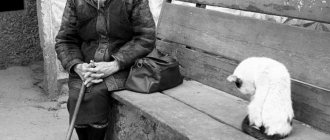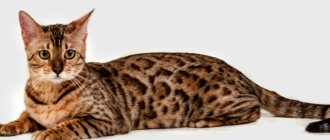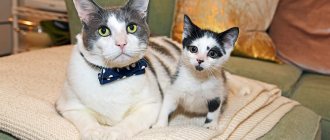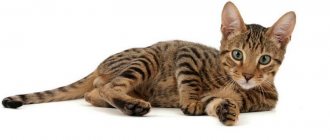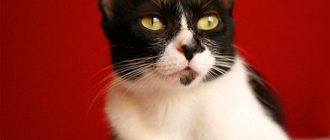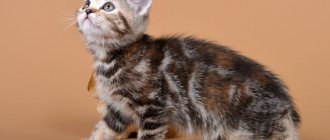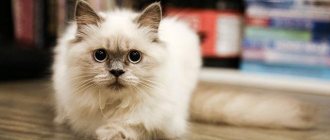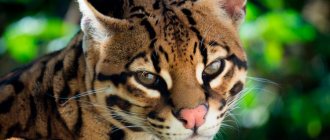This panther was born in a traveling zoo in Siberia, but it looks like it has found a much better life. A charming wild cat with a difficult fate was taken into her home by a girl from Siberia. The owner of the Moon is called Victoria, she does not name the city in which she lives, but happily shares stories about life with a panther under the same roof. The girl rescued her pet from a traveling zoo and decided to raise her at home. They live quite well: they eat and walk a lot. By the way, one of the most popular questions is, isn’t the Moon cold in winter? Victoria will be assured that no, because one of her parents is an Amur leopard, so Luna has a love of harsh winter in her blood.
Reproduction and lifespan
Females of large cats are ready to mate when they reach 1.5-3 years, males - a little later. There is no mating season; estrus continues until pregnancy occurs. Males prefer to live separately from females (with the exception of lions). The female independently takes care of the offspring, feeds and trains the babies. How long does he live? Representatives of the genus Panthera live from 12 to 25 years in natural conditions, and much longer in captivity.
Photo of a leopard and a black panther
Extinct species
The existence of many species of predators that have not survived to this day is evidenced by preserved skeletal bones. Research has made it possible to identify the main species of these animals, which include: the ancestors of leopards and pumas, two types of European jaguars, the ancestors of lions and tigers, and large lion-like cats Pahthera youngi.
More recent fossil animals include:
- tiger ancestors of the subspecies tigris acutidenis and tigris trinilensis, distributed in Siberia, China, and the islands of Indonesia;
- Cave Lions from the North American continent, distinguished by the absence of a mane;
- European cave Lions, painted with stripes like tigers;
- spotted lions from Africa;
- Ceylon Lions;
- European subspecies of Jaguars and Leopards.
In addition to the animals mentioned above, the cause of whose extinction was the natural course of the evolutionary process, several species are known that disappeared thanks to people:
- Tigers from o. Bali, the last copy of which was destroyed in 1937;
- Tigers of Transcaucasia are large animals that fought in gladiatorial battles of Ancient Rome;
- Tigers from o. Java, who survived until the eighties of the twentieth century;
- a Texas species of Jaguar that has ceased to exist today.
Confinement
Most people look at cats of the genus Panthera not as enemies or a desired hunting trophy, but as an integral part of the animal world of our planet. At the state level, measures are being taken to protect these beauties from barbaric extermination.
Many specimens of predators have found shelter in zoos in large cities, where conditions similar to the usual habitat of Panthers have been recreated. Protected areas and national parks in many countries take care of the growth of animal populations.
It is not uncommon for predators to be raised by humans. In the United States, 12 thousand tigers are in private hands. And this is provided that in many states there is a complete ban on such keeping of wild animals. Most pets have never lived in freedom and are descendants of circus animals or zoo inhabitants.
As a rule, animals living in captivity live longer lives than their wild relatives. For example, male lions live for more than two decades, whereas in natural conditions they usually die before they even last a decade. Today, zoos around the world have more than 1,000 lions.
The history of taming Lions is quite old. It is known that the commander Alexander the Great owned several tame lions brought from India. During the Roman Empire, animals took part in gladiator fights.
The keeping of large cats in medieval menagerie was characterized by cruelty. Since the Lion symbolized power and might, people often used animals for spectacular fights. Lion skins and heads were considered desirable hunting trophies. All this led to a sharp decline in the number of Panthers and threatened the existence of the population.
Modern humanity strives to correct the mistakes made in previous times. Living in captivity for large cats is organized humanely, taking into account the vital needs of the animals. Species that are at risk of extinction are listed in the Red Book and are protected by international laws.
Breed characteristics of the Bombay cat
- Head. Panthers have a round, neat, medium-sized head with a wide muzzle. Viewed from the front - without sharp bends or creases. When viewed in profile, the presence of a pronounced moderate sling is characteristic, which should not turn into a kink (flaw). The tip of the nose is slightly rounded down. The cat has a strong but not wide chin, rounded chin pads, a correct bite and a well-developed lower jaw. And also noticeable but taut cheeks and high cheekbones. A very smooth transition from the chin to the cheekbones. The breed has a narrow, visually even bridge of the nose with a barely perceptible small dimple, a wide and high sloping forehead, smoothly rounding and turning into the back of the head. Neck. Medium length and width, flexible and graceful.
- The ears are medium in size, wide and high set, alert. Rounded at the tips, without pubescence, with a slight forward slope.
- Eyes. Large in size, round in shape, very expressive, set wide apart. They are located widely on the muzzle. Honey-amber is considered the most successful color, but it is quite rare, so golden eyes are allowed.
- At birth, kittens have blue eyes , which after they reach the age of six months turns into gray, and only by the age of one year does a rich orange color appear. But animals with this eye color, especially cats, from about five years old, may disappoint you - the eye color may suddenly change to greenish.
- Body. Medium, slightly elongated. With well-developed muscles and amazing flexibility. A petite or thin body type is not acceptable. The breed is characterized by a proportionally wide back, level and sloping. The shoulder and pelvic girdles are almost the same width.
- Paws. Not long, with a characteristic slenderness, proportional. The ends of the legs are rounded with tucked toes. (there should be 5 toes on the front legs and 4 on the hind legs, any other number is unacceptable).
- Tail. Should be in proportion to the body, dense, strong, straight, with characteristic flexibility and mobility, slightly tapering towards the end. If the tail is bent or disproportionate to the body, the animal is disqualified.
Bombays are medium-sized cats - from 25 to 30 cm at the withers. Body weight of an adult pet: females - 3-4 kg, males 4-6 kg.
Characteristics of coat and color. The coat should be short, close-fitting and shiny, as if covered with varnish. Only black coat color is allowed. Young kittens may have small white spots on their fur and slight fluffiness, but by the age of one year the fur coat changes to that of an adult. Everything should be black - from the crumbs on the fingers to the nose.
The image of the black panther in human culture
The graceful, coal-colored predator has long attracted people's attention. The image of this beast can be found on the aristocratic coats of arms of the most glorious European monarchs. German heraldists preferred to use modified images, adding horns, cow ears, and a fiery tongue.
Our contemporaries associate the image of a black panther with Bagheera from Kipling's The Jungle Book.
Numerous dream interpreters offer the following interpretations of the appearance of a predatory cat in a dream plot:
- An animal proudly walking through the forest is the fulfillment of ambitious plans.
- A predator climbing a tree is a career failure.
- Hunting scene - quarrel with friends.
- A female with babies is a chance meeting with an interesting person.
- A predator caught in a cage is the fulfillment of a plan.
- A large animal means an enemy, and the coal color indicates that the enemy has influential support.
- A battle in which the predator wins means failure in business.
- A battle in which a man defeats a beast is success in his endeavors.
- A tamed and affectionate panther is a significant success and an increase in authority.
- Feeding a predator from your hands means support from high authorities.
Details about the breed
Characteristics of the Bombay cat
Animals are characterized by sociability and a pleasant voice. They love to spend time on their owner’s lap and enjoy stroking and affection. Black panthers love company and do not tolerate loneliness well. They don’t enter into open conflicts, they don’t show aggression – they simply retreat to a safe place. They are calm with other pets in the house - both dogs and parrots. They get along great with children.
Cats do not welcome walks on the street, they do not want to jump out of the house, this is an exclusively domestic breed. At home, this is a playful, active cat and at the same time calm, with a balanced character. According to some sources, this breed is very easy to train.
Features of maintenance and care
The short coat of the Bombay does not create any special problems in care - regular brushing of the pet with a rubber mitten is enough. To make the coat shine, you can use a piece of suede - just rub the coat with it. Around the age of one year, the kitten's fur begins to change to that of an adult. It is during this period that active combing of fluff is recommended.
Eye care. Regular hygienic cleaning of the eyes with a damp cotton pad will easily eliminate the effects of increased tear production, which is typical for representatives of this breed. Carry out regular inspection and, if necessary, cleaning of the ears.
Regular brushing of teeth and prevention of tartar (hard pieces of food, special sticks for chewing) are recommended. The claws of cats of this breed are long and strong. It is recommended to trim them regularly and have a freely accessible scratching post.
Features of feeding Bombay cats
Representatives of this breed are characterized by a lack of sense of proportion in food. Therefore, strictly dosed feeding twice a day is recommended, otherwise the animal will quickly gain excess weight.
Health
Hereditary diseases specific to this breed include hypertrophic cardiomyopathy and congenital deformation of the facial bones of the skull, which manifests itself in the form of asymmetry of the muzzle, jaw and sinuses, which can result in breathing problems.
Hypertrophic cardiomyopathy in a pet can be suspected if the pet has sudden fainting, sleeps too much, or has shortness of breath or rapid breathing. It is recommended to contact a veterinarian.
Attention! Bombays are sensitive to drafts and hypothermia.
Despite possible health problems, the pet can please its owners with a fairly long life expectancy - from 15 to 20 years.
Vaccination. It is carried out after mandatory treatment against blood-sucking parasites and deworming, just like for other representatives of the cat family. If necessary, the veterinarian draws up an individual vaccination schedule.
